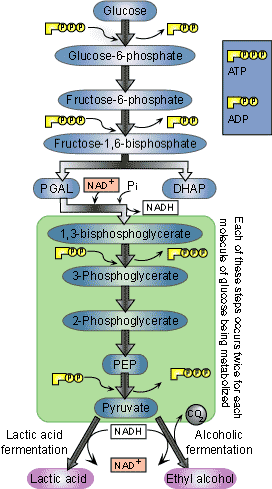On Fermentation
With all the recent talk of the Reedsburg Fermentation Fest and Justin's current adventures in beer brewing (where's that long promised post, JH?!), I got to thinking about how my knowledge of fermentation is actually pretty rudimentary. I mean, I know that it has something to do with microorganisms changing food in ways we want (as opposed to ways we don't want, as with decomposition), but what do all those different products--yogurt, pickles, beer, wine, cheese, bread--really have in common?
I know enough to know that the best guide to all this is Wild Fermentation, by Sandor Ellix Katz, also known as Sandorkraut, the self-proclaimed "fermentation fetishist." But since I haven't read that book (shame on me!), here's the bits and pieces I've thus far been able to glean from various sources.
Scientifically, the process looks like this:
Some kind of carbohydrate turns into some kind of acid or alcohol (or carbon dioxide, I think). With wine and beer and cider, obviously, it's alcohol that's produced. With bread, carbon dioxide. With sauerkraut and yogurt and kimchi, lactic acid. Different bacterial strains and yeast, with different inputs, yield different outputs. Basically.
There a bunch of reasons that people do this, among them preservation (the development of certain acids and alcohols delays the decomposition of food), taste (yum!), and health (many people think that healthy bacteria have probiotic characteristics that promote body functions; Sharon Astyk has written that during her pregnancies, because of morning sickness, fermented foods were the only things she could stomach).
There's a really fascinating list on Wikipedia of fermented foods by region:
What do you all know about fermentation? Sounds pretty cool, doesn't it?
I know enough to know that the best guide to all this is Wild Fermentation, by Sandor Ellix Katz, also known as Sandorkraut, the self-proclaimed "fermentation fetishist." But since I haven't read that book (shame on me!), here's the bits and pieces I've thus far been able to glean from various sources.
Scientifically, the process looks like this:
Some kind of carbohydrate turns into some kind of acid or alcohol (or carbon dioxide, I think). With wine and beer and cider, obviously, it's alcohol that's produced. With bread, carbon dioxide. With sauerkraut and yogurt and kimchi, lactic acid. Different bacterial strains and yeast, with different inputs, yield different outputs. Basically.
There a bunch of reasons that people do this, among them preservation (the development of certain acids and alcohols delays the decomposition of food), taste (yum!), and health (many people think that healthy bacteria have probiotic characteristics that promote body functions; Sharon Astyk has written that during her pregnancies, because of morning sickness, fermented foods were the only things she could stomach).
There's a really fascinating list on Wikipedia of fermented foods by region:
- Worldwide: alcohol, wine, vinegar, olives, yogurt, bread, cheese
- Asia
- East and Southeast Asia: amazake, asinan, atchara, bai-ming, belacan, burong mangga, com ruou, dalok, doenjang, douchi, jeruk, lambanog, kimchi, kombucha, leppet-so, narezushi, miang, miso, nata de coco, nata de pina, natto, naw-mai-dong, oncom, pak-siam-dong, paw-tsaynob, prahok, ruou nep, sake, seokbakji, soju, soy sauce, stinky tofu, szechwan cabbage, tai-tan tsoi, chiraki, tape, tempeh, totkal kimchi, yen tsai, zha cai
- Central Asia: kumis (mare milk), kefir, shubat (camel milk)
- South Asia: achar, appam, dosa, dhokla, dahi (yogurt), idli, kaanji, mixed pickle, u-to-nga, jaand (rice beer), sinki, tongba, panir
- Africa: fermented millet porridge, garri, hibiscus seed, hot pepper sauce, injera, lamoun makbouss, laxoox, mauoloh, msir, mslalla, oilseed, ogi, ogili, ogiri
- Americas: chicha, elderberry wine, kombucha, pickling (pickled vegetables), sauerkraut, lupin seed, oilseed, chocolate, vanilla, tabasco, tibicos
- Middle East: kushuk, lamoun makbouss, mekhalel, torshi, boza
- Europe: rakfisk, sauerkraut, ogórek kiszony, surströmming, mead, elderberry wine, salami, prosciutto, cultured milk products such as quark, kefir, filmjölk, crème fraîche, smetana, skyr.
- Oceania: poi, kaanga pirau (rotten corn), sago
What do you all know about fermentation? Sounds pretty cool, doesn't it?

What do I know about fermentation? I know that Korean rice wine, if left to ferment longer than it should, winds up smelling and tasting like cheese, but in about the worst way imaginable. I also know that if you make a sourdough starter and leave it in the fridge unattended for two months while you return to your homeland, it will develop a thick, black sludge-crust and stink up your apartment.
ReplyDeleteTRIVIA: Koreans divide Kimchi into two kinds (well, actually, hundreds, but two in this sense): plain and "sour." Plain kimchi hasn't been fermenting that long and is eaten raw with rice at meals. Sour kimchi has been fermenting for months on end and is a little too sour to eat pleasantly, but is great for stir-fries, stews, and pancakes.
OK, so I was derelict on reading your blog lately due to application-writing. But now I am back! You've got to, got to, got to check out Wild Fermentation. I have become obsessed. So much so that I secretly started a fermentation blog a few weeks back. It is not as thoughtful and thought-provoking as yours! Just recipes! I wanted to document how different fermentations went, since they are always a little different. And, if anyone ever reads it, hopefully it will help to see what different stages look like. I didn't want to advertise until I was sure I'd keep it up (though I'm already behind on showing my last batch of tempeh). But hey, here it is: http://kitchenecosystems.wordpress.com/
ReplyDeleteMegan! I love Kitchen Ecosystems already and am subscribed in my Google Reader. You're gonna get me started, I'm sure... Ooh, and you should try your hand at kimchi!
ReplyDelete